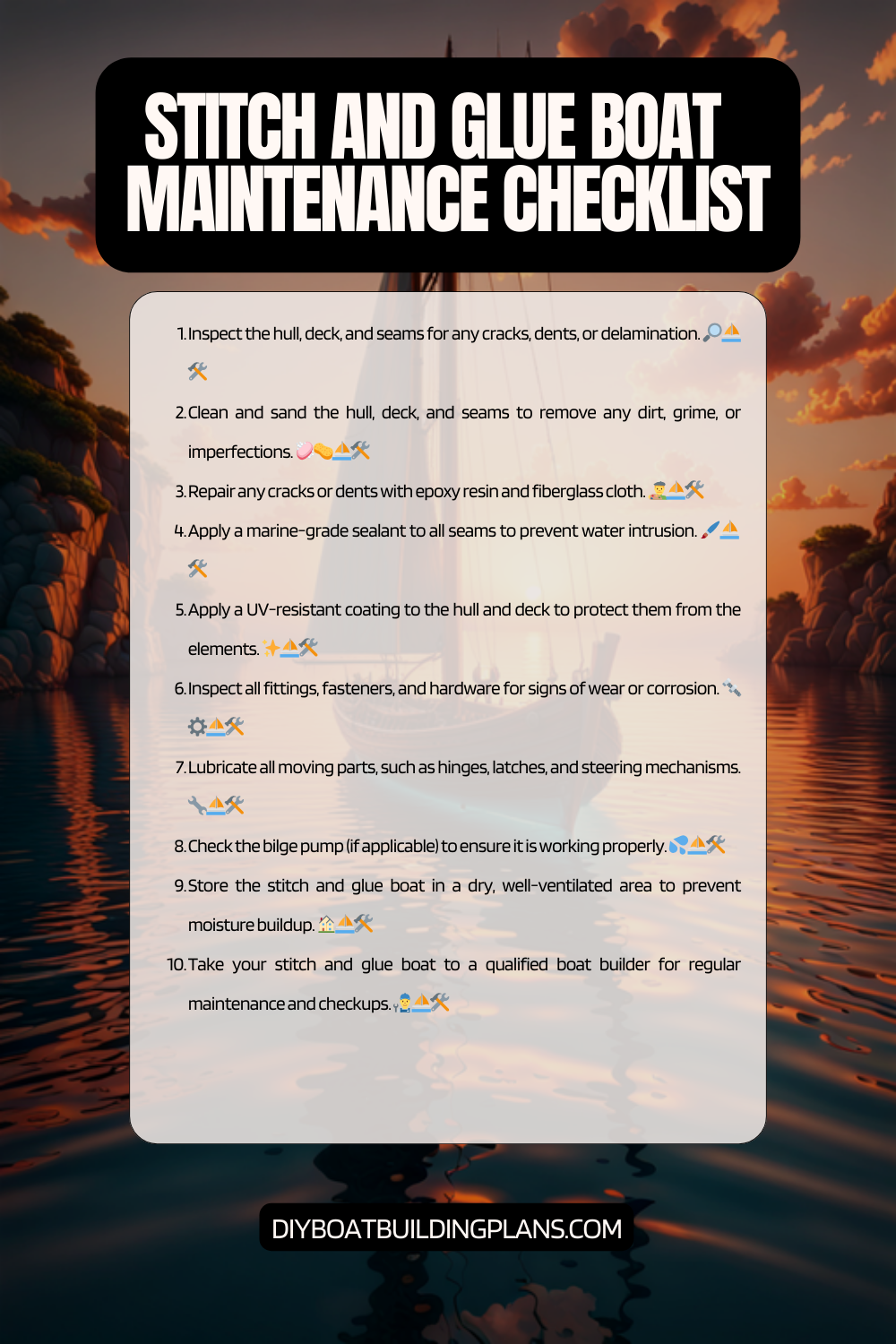Overview of Stitch and Glue Boat Maintenance Tips
Stitch and glue boats are a popular type of boat construction method that involves stitching together plywood panels and then gluing them together with epoxy resin. This technique is widely used in the building of small boats, such as kayaks, canoes, and dinghies. The process is relatively simple and requires minimal tools and materials, making it accessible to both experienced boat builders and beginners.
One of the main advantages of stitch and glue boats is their lightweight construction. The use of plywood panels instead of traditional planks or fiberglass results in a lighter boat, which in turn improves its performance on the water. Additionally, stitch and glue boats are known for their strength and durability. The combination of stitching and gluing creates a strong bond between the panels, making the boat resistant to impacts and stress.
Key Takeaways
- Regular maintenance is crucial for stitch and glue boats to ensure their longevity and safety.
- Cleaning and washing the boat regularly can prevent the buildup of dirt and grime that can damage the hull.
- Inspecting the hull for damage, repairing cracks and holes, and checking seams and joints can prevent water from seeping into the boat.
- Maintaining the paint and varnish can protect the boat from UV rays and saltwater corrosion.
- Properly winterizing and storing the boat can prevent damage from freezing temperatures and moisture.

Importance of Regular Maintenance
Regular maintenance is crucial for stitch and glue boats to ensure their longevity and optimal performance. By regularly inspecting, cleaning, and repairing your boat, you can prevent minor issues from turning into major problems. Neglecting maintenance can lead to structural damage, leaks, and decreased performance on the water.
One of the key benefits of regular maintenance is the prevention of damage. By inspecting your boat regularly, you can identify any signs of wear or damage early on. This allows you to address the issues promptly before they worsen. Regular maintenance also helps to maintain the boat’s appearance. By cleaning and maintaining the paint and varnish, you can keep your stitch and glue boat looking its best.
Cleaning and Washing the Boat
Cleaning and washing your stitch and glue boat should be a regular part of your maintenance routine. Start by rinsing off any dirt or debris with fresh water. Use a soft brush or sponge to scrub away any stubborn stains or grime. Avoid using harsh chemicals or abrasive cleaners that could damage the finish or the epoxy resin.
When it comes to cleaning products, opt for mild, non-abrasive cleaners that are safe for use on fiberglass and epoxy surfaces. There are many boat-specific cleaners available on the market that are designed to effectively remove dirt and stains without causing any harm. Additionally, using a boat wash or soap specifically formulated for marine use can help to protect the boat’s finish and prevent oxidation.
Inspecting the Hull for Damage
| Inspection Metric | Description | Measurement |
| Hull Thickness | Measurement of the thickness of the hull | Inches |
| Cracks | Number of cracks found on the hull | Count |
| Corrosion | Amount of corrosion found on the hull | Percentage |
| Weld Quality | Quality of the welds on the hull | Pass/Fail |
| Paint Condition | Condition of the paint on the hull | Good/Fair/Poor |
Regularly inspecting the hull of your stitch and glue boat is essential to catch any signs of damage early on. Start by visually inspecting the entire hull, both inside and outside, looking for any cracks, dents, or delamination. Pay close attention to areas that are prone to stress or impact, such as the bow and stern.
If you notice any cracks or holes, it is important to address them promptly to prevent further damage. Small cracks can be repaired using epoxy resin and fiberglass cloth. For larger cracks or holes, you may need to cut out the damaged section and replace it with a new piece of plywood. It is crucial to follow proper repair techniques and use appropriate materials to ensure a strong and lasting repair.
Repairing Cracks and Holes
Repairing cracks and holes in the hull of a stitch and glue boat requires careful attention to detail and the use of suitable materials. Start by cleaning the damaged area thoroughly, removing any loose or damaged material. If necessary, sand the area around the crack or hole to create a smooth surface for the repair.
For small cracks or holes, mix epoxy resin according to the manufacturer’s instructions and apply it to the damaged area using a brush or spatula. Press fiberglass cloth into the wet epoxy, ensuring that it fully saturates the cloth. Apply additional layers of epoxy and fiberglass cloth as needed until the repair is flush with the surrounding surface.
For larger cracks or holes, you may need to cut out the damaged section and replace it with a new piece of plywood. Use a jigsaw or similar tool to carefully remove the damaged section, making sure to follow the shape of the existing hull. Cut a replacement piece of plywood to fit the opening and secure it in place using epoxy resin and fiberglass cloth.
Checking the Seams and Joints
Checking the seams and joints of your stitch and glue boat is crucial to ensure their integrity and prevent leaks. Over time, the epoxy resin used to bond the plywood panels together may degrade or become damaged, compromising the strength of the boat. Regularly inspect the seams and joints for any signs of separation, cracking, or delamination.
If you notice any issues with the seams or joints, it is important to address them promptly. Start by cleaning the area around the seam or joint, removing any dirt or debris. Mix epoxy resin according to the manufacturer’s instructions and apply it to the damaged area using a brush or spatula. Use clamps or weights to hold the joint together while the epoxy cures.
Maintaining the Paint and Varnish
Maintaining the paint and varnish on your stitch and glue boat not only enhances its appearance but also protects it from UV damage, water intrusion, and general wear and tear. Regularly inspect the paint and varnish for any signs of peeling, cracking, or fading. If necessary, touch up or repaint these areas to maintain a protective barrier.
Before applying any paint or varnish, ensure that the surface is clean and free from dirt, grease, and loose material. Sand any rough areas or imperfections to create a smooth surface for painting or varnishing. Use marine-grade paint or varnish that is specifically formulated for use on boats. Apply multiple thin coats rather than one thick coat for better adhesion and durability.
Lubricating Moving Parts
Proper lubrication of moving parts is essential to ensure smooth operation and prevent premature wear. Regularly lubricate hinges, latches, pulleys, and any other moving parts on your stitch and glue boat. Use a marine-grade lubricant that is suitable for the specific application.
Before applying lubricant, clean the moving parts thoroughly to remove any dirt or debris. Apply a small amount of lubricant to the moving parts, ensuring that it reaches all the necessary areas. Wipe away any excess lubricant to prevent accumulation of dirt or grime.
Download over 500 Boat Plans. Click on the link below.
-->Click Here<--
Winterizing the Boat
Winterizing your stitch and glue boat is crucial if you live in an area with freezing temperatures or if you plan to store the boat for an extended period. Start by thoroughly cleaning the boat, removing any dirt, algae, or other organic matter. Drain all water from the boat, including bilge water and any water trapped in compartments or storage areas.
To protect the boat from freezing temperatures, it is important to remove any water from the plumbing system. Use compressed air to blow out all water lines, faucets, and pumps. Add antifreeze to the toilet, sink drains, and any other plumbing fixtures to prevent freezing and damage.
Storing the Boat Properly
Proper storage is essential to protect your stitch and glue boat from damage during periods of non-use. When storing your boat, choose a location that is dry, well-ventilated, and protected from extreme temperatures and direct sunlight. If possible, store the boat indoors or under a covered area.
Before storing the boat, thoroughly clean and dry it to remove any dirt or moisture. Cover the boat with a breathable cover that provides protection from dust and debris while allowing air circulation. If storing the boat on a trailer, ensure that the trailer is in good condition and properly supports the weight of the boat.
Stitch and Glue Boat Maintenance Checklist

Conclusion – Stitch and Glue Boat Maintenance Tips
In conclusion, regular maintenance is essential for stitch and glue boats to ensure their longevity, performance, and appearance. By following the tips and recommendations outlined in this article, you can keep your stitch and glue boat in optimal condition. Remember to regularly inspect, clean, and repair your boat, paying close attention to the hull, seams, joints, paint, varnish, and moving parts. Proper winterization and storage procedures are also crucial to protect the boat during periods of non-use. With proper maintenance, your stitch and glue boat will provide you with years of enjoyment on the water.
FAQs – Stitch and Glue Boat Maintenance Tips
What is a stitch and glue boat?
A stitch and glue boat is a type of boat construction method that involves stitching panels of plywood together with wire or cable ties and then gluing the seams with epoxy.
What are some common maintenance issues with stitch and glue boats?
Common maintenance issues with stitch and glue boats include checking for leaks, repairing any damage to the epoxy seams, and maintaining the finish of the boat.
How often should I check for leaks in my stitch and glue boat?
It is recommended to check for leaks in your stitch and glue boat at least once a year, or more frequently if you use the boat frequently or in rough conditions.
How do I repair damage to the epoxy seams in my stitch and glue boat?
To repair damage to the epoxy seams in your stitch and glue boat, you will need to remove any damaged epoxy, clean the area, and then apply new epoxy to the seam.
What is the best way to maintain the finish of my stitch and glue boat?
To maintain the finish of your stitch and glue boat, it is recommended to wash the boat regularly with soap and water, and to apply a protective coating of marine wax or varnish to the exterior surfaces.



